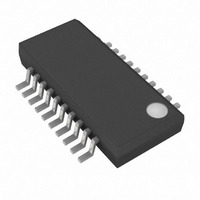MAX1962EEP+ Maxim Integrated Products, MAX1962EEP+ Datasheet - Page 13

MAX1962EEP+
Manufacturer Part Number
MAX1962EEP+
Description
IC DC-DC CTRL STP DWN 20-QSOP
Manufacturer
Maxim Integrated Products
Type
Step-Down (Buck)r
Datasheet
1.MAX1960EEP.pdf
(29 pages)
Specifications of MAX1962EEP+
Internal Switch(s)
No
Synchronous Rectifier
No
Number Of Outputs
1
Voltage - Output
0.8 ~ 4.95 V
Current - Output
20A
Frequency - Switching
500kHz, 1MHz
Voltage - Input
2.35 ~ 5.5 V
Operating Temperature
-40°C ~ 85°C
Mounting Type
Surface Mount
Package / Case
20-QSOP
Power - Output
727mW, 9.1mW
Lead Free Status / RoHS Status
Lead free / RoHS Compliant
The MAX1961 has four output voltage presets selected
by SEL. Table 2 shows how each of the preset voltages
are selected. The MAX1962 also has four preset output
voltages, but also is adjustable down to 0.8V. To use the
preset voltages on the MAX1962, FB must be connected
to V
Table 2.
Both the MAX1960/MAX1962 feature an adjustable out-
put that can be set down to 0.8V. To set voltages greater
than 0.8V, Connect FB to a resistor-divider from the out-
put (Figures 9 and 11). Use a resistor up to 10kΩ for R2
and select R1 according to the following equation:
where the feedback threshold, V
the output voltage.
The MAX1960/MAX1961/MAX1962 have an input volt-
age range of 2.35V to 5.5V but cannot operate at both
extremes with one application circuit. The standard
charge-pump doubler application circuit operates with
an input range of 2.7V to 5.5V (Figures 9, 10, and 11).
In order to operate down to 2.35V, the charge pump
must be configured as a tripler. This circuit, however,
limits the maximum input voltage to 3.6V. The schematic
for the tripler charge pump is shown in Figure 2. Note
that the flying capacitor between C+ and C- has been
removed and C+ is not connected.
Determine an appropriate inductor value with the fol-
lowing equation:
The inductor current ripple, LIR, is the ratio of peak-to-
peak inductor ripple current to the average continuous
inductor current. An LIR between 20% and 40% pro-
Inductor operating point. This choice provides
tradeoffs between size, transient response, and effi-
ciency. Choosing higher inductance values results
in lower inductor ripple current, lower peak current,
lower switching losses, and, therefore, higher effi-
ciency at the cost of slower transient response and
larger size. Choosing lower inductance values
results in large ripple currents, smaller size, and
poorer efficiency, but have faster transient response.
Step-Down Controllers with Voltage Margining
DD
L V
=
. SEL then selects the output voltage as shown in
OUT
×
2.35V to 5.5V, 0.5% Accurate, 1MHz PWM
R
V
1
IN
______________________________________________________________________________________
=
R
×
Setting the Output Voltage
2
f
OSC
×
⎛
⎜
⎝
V
V
IN
V
×
Input Voltage Range
OUT
FB
-
LIR
Inductor Selection
FB
V
OUT
-
= 0.8V, and V
×
1
⎞
⎟
⎠
I
LOAD MAX
(
)
OUT
is
vides a good compromise between efficiency and
economy. Choose a low-loss inductor having the lowest
possible DC resistance. Ferrite core type inductors are
often the best choice for performance. The inductor
saturation current rating must exceed I
The MAX1960/MAX1961 use the low-side MOSFET’s on-
resistance (R
current limit sets the maximum value of the inductor’s
“valley” current (Figure 3). If the inductor current is higher
than the valley current-limit setting at the end of the
clock period, the controller skips the DH pulse. When
the first current-limit event is detected, the controller initi-
Table 2. Preset Voltages—
MAX1961/MAX1962
Figure 2. Tripler Charge-Pump Configuration.
PRESET OUTPUT VOLTAGE
I
PEAK
Lossless Current Limit (MAX1960/MAX1961)
MAX1960/
MAX1961/
MAX1962
1.5V
1.8V
2.5V
3.3V
=
DS(ON)
V
I
CC
LOAD MAX
C10, C11, C12
AV
C6
V
) for current sensing. This method of
C+
DD
DD
C-
(
C10
D2
Setting the Current Limit
)
500kHz
+
4.7µF
1µF
⎛
⎜
⎝
D3
C11
LIR
R5
10Ω
C4
1µF
2
⎞
⎟ ×
⎠
No connection
0.47µF
2.2µF
1MHz
D4
C12
PEAK
I
LOAD MAX
GND
SEL
C6
REF
V
DD
:
D5
(
)
13











